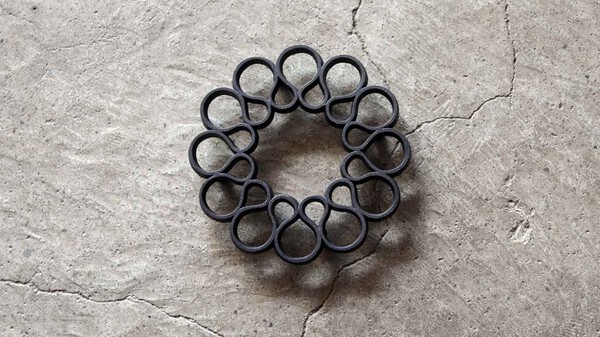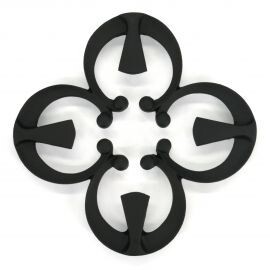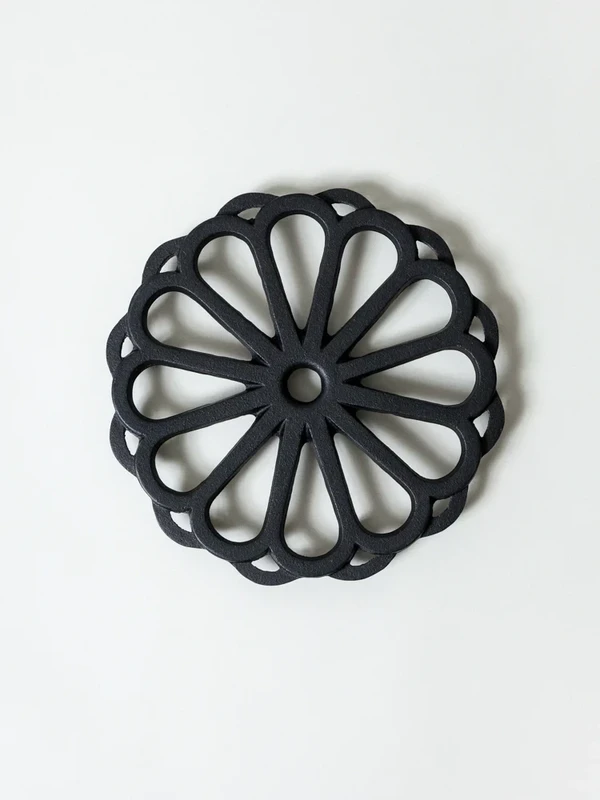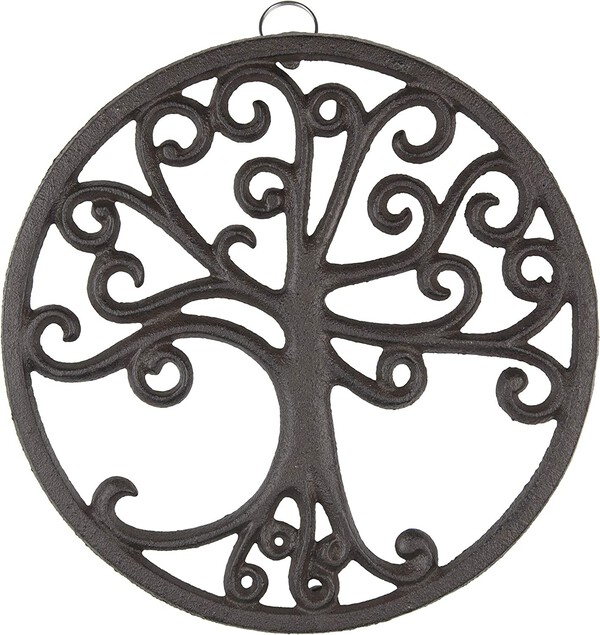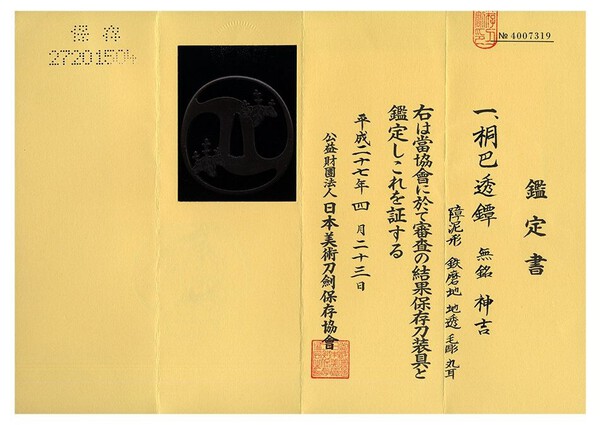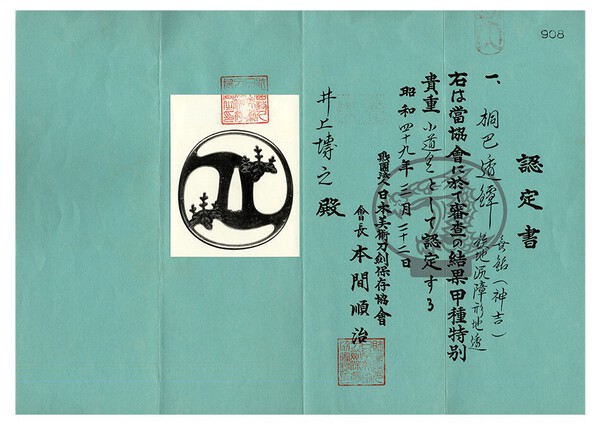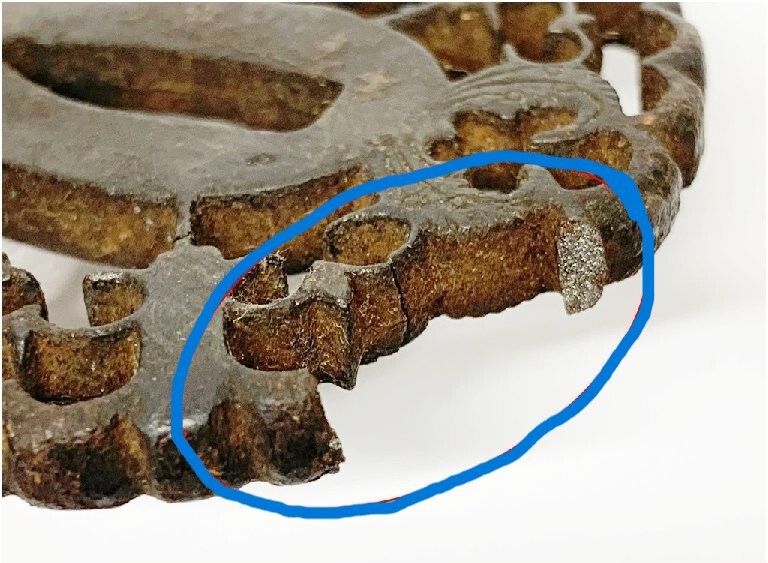
Dan tsuba
Gold Tier-
Posts
761 -
Joined
Everything posted by Dan tsuba
-
Hello all! Now, after looking at the “tsuba rust” video again the young man states something like “you will understand why rust can protect tsuba”. Maybe that is something he will show in his next video? So, there I was, minding my own business not looking for anything! I was researching some tsuba information and came upon this statement: found on page 40 of "Japanese Sword-Mounts"- “Contemporaneous, if not of earlier date, are the tsuba reproduced in Plates V and VI. They are of iron and covered with a patina of fine smoothness. While age has undoubtedly done much to produce this "skin," it is more than likely that one of the several methods known as sabi-dashikata ("rust-summoning process") was applied to some of these tsuba. The old iron workers had recipes for producing patina, which they guarded with great secrecy and kept among their hiden ("secret processes") handed down from generation to generation. Some of these methods have been outlined in published accounts, but almost all serious searchers after authentic information on tsuba agree that these same accounts are intended to deceive rather than instruct. The one quoted by F. Brinkley 1 is typical and full of quaint fancies. Once the patina has become scratched or rubbed, the tsuba loses much of its value ; for it is the color and "feel" of the iron, as well as the handling and design, which combine to make the artistic appeal of these tsuba. It is very difficult to restore a patina that has become harmed. From a personal letter of Joly, who spent much of his time on the study of Japanese sword-mounts, and who left the most valuable information which we have concerning them, is quoted the following paragraph: — , "The problem of patinating iron and Japanese alloys is far from simple ; I have worked at it for more years than I care to remember, and have collected many recipes, some of which do work. — In years gone by I can still remember a dozen or so bottles of pickling solutions gathering dust on the shelves of my laboratory, some of which worked on shakudo, others on shibuichi, which one day were all turned into a larger bottle, and the resulting mess, the composition of which is wholly unknown, does patinate anything it is applied to. — Thank goodness I have enough of it to last as long as I shall, unless the bottle gets broken !" The "resulting mess" was never analyzed, and unfortunately Mr. Joly's valuable researches were brought to a close by his premature death in 1920.” The above information was found in “Japanese Sword Mounts in the Collections of Field Museum”, by Helen Cowen Gunsaulus - first published in 1923. A downloadable copy can be found at the below link- https://archive.org/details/japaneseswordmou16guns/page/40/mode/1up So, I was thinking what the above stated “rust-summoning process” was (and if that was what the young man in the “rust” video was alluding to?) Well, more research led to finding out that there is a rusting process called “flash rusting”. The resource I found the information in is listed below, and it was written in 2014. https://www.canada.ca/en/conservation-institute/services/training-learning/in-person-workshops/understanding-flash-rusting.html The specific section is “Immersion of carbon steel coupon in tap water”. Although there are interesting areas for study in other parts of the article. I have included the specific section of the article below- (I couldn't download the pictures associated with the article - so if you want to see the pictures just click on the above link!) “Immersion of carbon steel coupon in tap water When a carbon steel coupon is first immersed in tap water, the surface is bright and shiny, as shown in Figure 10. Before immersion, this coupon had been cleaned with acetone, then abraded with 220 grit sandpaper. Within 5 minutes, there is evidence of corrosion as orange rust starts to form. Figure 11 shows the surface after it has been immersed for 30 minutes in tap water. The surface of the coupon gradually becomes more orange over the next few hours. Figure 12 shows the carbon steel coupon after 5 hours of immersion.” © Government of Canada, Canadian Conservation Institute. CCI 127992-0014 Figure 10. A carbon steel coupon just after it has been immersed in tap water. © Government of Canada, Canadian Conservation Institute. CCI 127992-0016 Figure 11. A carbon steel coupon 30 minutes after it has been immersed in tap water. © Government of Canada, Canadian Conservation Institute. CCI 127992-0017 Figure 12. A carbon steel coupon 5 hours after it has been immersed in tap water. After several days, the surface of the coupon becomes bright orange. Figure 13 shows the carbon steel coupon after 72 hours (3 days) of immersion in tap water. When the coupon is removed from the solution and the orange residue wiped off, the surface beneath should be darkened, as shown in Figure 14. © Government of Canada, Canadian Conservation Institute. CCI 127992-0019 Figure 13. A carbon steel coupon 72 hours (3 days) after it has been immersed in tap water. © Government of Canada, Canadian Conservation Institute. CCI 127992-0020 Figure 14. The carbon steel coupon after the orange corrosion has been gently wiped off. The underlying surface has darkened in areas. So, in summary, is it possible that “flash rusting” was used in the patina process, and also to protect the tsuba from further rusting? I don’t know, just some more interesting research in the quest for tsuba knowledge! The adventure continues! With respect, Dan
-
Hello all, As an interesting addition to the post by Thomas about the findings from ancient Japanese casting sites (and parts of the below article deal with cast iron kettle making) I would like to add the following information: “4.2. Kettles in Ancient Japan (7–11 century) The oldest production of cast iron object in Japan was pursued at casting factory of the north region of Kawaharadera Temple of Asuka, Nara Prefecture, in the end of 7 century. This is a large-sized Hagama, and was casted in the casting pit. In those days the bathroom for priests was annexed to Buddhist temples, and iron Hagama for boiling water were prepared there. This Hagama is not a kettle which is used as a cooking vessel, but a particular religious tool, and it was maybe made by the special technology which was imported from foreign country along with popularity of Buddhism in Nara period. From many smelting sites which were located on gently sloping hill of Souma (Fukushima Prefecture), Kashiwazaki (Niigata Prefecture), Imizu (Toyama Prefecture), Kanto Plain, and Konan (Shiga Prefecture), many molds of kettles of 9–10 century were excavated. Recently in Kawatodai site (Ibaraki Prefecture), a large-sized site of casting factory in Kanto district was discovered, and a great many molds of kettles were excavated.21) Common point in kettle casting sites of 9–10 century is that cast iron production was pursued in the smelting factory or in the surrounding area. From excavated molds, products are Nabe and Hagama, and they have three legs under their bottom. They need not be put on kitchen range, but independently used. They belong to small-sized object, and so casting pit for large-sized objects has never found. Although these casting sites of cast iron kettle broadly spread from Tohoku to Kinki, there is no regional difference of form of vessel. Precisely examining these ancient molds of cast iron, core print by which fix mold and core is not clear. This is a different from medieval mold of kettle. As ancient casting sites are located considerably in north-east Japan, ancient casting production was influenced by Bohai or Liao which ruled north east district of China, Y. Kojima thinks.22) But it was influenced by Korean casting production.23)” And there is more interesting information to be found in the article. The above information was found at the below listed website- https://www.jstage.jst.go.jp/article/isijinternational/54/5/54_1123/_html/-char/ja The paper appears to have been written in Japan in 2014. Although it states nothing about tsuba, I find it a very interesting read about cast iron production in Japan and decided to “pass it on” to others. With respect, Dan
-
Hello all, I think I recall a post to a thread on the NMB forum (cannot remember which thread it was or if I read it somewhere else) where someone described Ford Hallem “as considered the West’s leading expert on tsuba” (or words to that effect). Now, that is a great honor! I believe if this entire thread is read from beginning to end, it will clearly be seen that many contributors have verified their research by stating references where they located the information. They are not stating opinions, but rather statements backed by (sometimes) painstaking research. It is also my belief that many of those contributors are “university educated” individuals (as I am). Their research methodology was learned over several years of formal education. Now, as stated above, Ford Hallem may have been described “as considered the West’s leading expert on tsuba”. Again, that is a great honor. And congratulations, Ford! But “who is considered the East’s leading expert on tsuba”? Or more specifically “who is considered East Asia’s leading expert on tsuba? And why haven’t we heard from him? Now, Ford, in one of his latest posts to the thread stated a very humorous fact- “I'll end by sharing this, sent to me by Greg Irvine, recently retired Senior curator at the V&A, so a serious scholar, The Samurai, as a class, were dissolved in 1867 The 'printing telegraph', the first fax, was invented in 1843 Abraham Lincoln was assassinated in 1865 so There was a 20 year window in which a Samurai could have faxed Abraham Lincoln.” That is indeed very funny! And although the information is from a “serious scholar” I believe it is flawed. That is because there were no direct telegraph lines installed between the United States and Japan until 1901. “The Commercial Pacific Cable Company Founded in 1901, the company provided the first direct telegraph route from America to the Philippines, China, and Japan. Prior to this, messages had to travel across the Atlantic to the Far East via Capetown and the Indian Ocean, or via London to Russia, then across the Russian landline to Vladivostock, then by submarine cable to Japan and the Philippines.” Found at the below website- https://atlantic-cable.com/CableCos/ComPacCable/index.htm Now, in the paragraph stated above there is mention of a “land line”. A “land line” is defined as a telephone. The telephone was not invented until 1876. So, although the “serious scholar” statement is funny, it is incorrect! Anyway- Gentleman, we are not trying to discover a cure for cancer here! Tsuba collecting is extremely educational, interesting, and sometimes exciting. But most of all it is “fun”! I have found that, oftentimes, people take themselves much too seriously. When tsuba collecting stops being fun for me, then that will signal the time for me to “exit” the hobby! This forum is a fine place to ask questions and share ideas and thoughts. In several of the threads a “lively discourse” of varying opinions often takes place. However, I believe there is still much “out there” to be discovered and learned about tsuba. I am reminded of a quote from a famous Zen master in his book- “Zen Mind, Beginner's Mind: Informal Talks on Zen Meditation and Practice” by Shunryu Suzuki “In the beginner’s mind there are many possibilities; in the expert’s mind there are few…. In the beginner’s mind there is no thought, ‘I have attained something.’ All self-centered thoughts limit our vast mind. When we have no thought of achievement, no thought of self, we are true beginners. We can really learn something.” ~ Shunryu Suzuki Also, I would like to repeat something I previously stated on a post to this thread- “I never underestimate the innate quality of man’s ingenuity. To do so would be a mistake.” If this thread is read in its entirety I am personally convinced (from all the excellent research presented in the thread) that cast iron tusba were produced during the Edo period (even maybe as early as the 1600’s). But that is just my thought on the subject! As for the multitude of other tsuba collectors out there, they will have their own opinions. Thank you all very much! With respect, Dan
-
Roger, You are too kind! Your input into the progression of this "amazing" (in my opinion) thread is much appreciated!! Yes, my friend, you are correct. There is still "maybe a little way to go yet". We will see what happens! With respect, Dan
-
“Tsuba- The tsuba (鍔, or 鐔) is usually a round (or occasionally squarish) guard at the end of the grip of bladed Japanese weapons, like the katana and its variations, tachi, wakizashi, tantō, naginata etc. They contribute to the balance of the weapon and to the protection of the hand. The tsuba was mostly meant to be used to prevent the hand from sliding onto the blade during thrusts as opposed to protecting from an opponent's blade.” The above was found at this website- https://en.wikipedia.org/wiki/Japanese_sword_mountings So, Jean- There you go again, making me do more research!! Thank you!! Onward! With respect, Dan
-
Jean, Throughout about the 10 months that this thread has appeared on the forum you have been a great and valuable help. Your insights, thoughts and opinions are of excellent value; and they are much appreciated! You always seem to “challenge” me. That is much appreciated, since it forces this “old man” to continue his research. In so doing I am constantly learning. Thank you! Now, in your most recent post you again “challenged” me with your below statement which refers to a quote from my previous post-- “.... there is very little (almost none!) historical evidence written about “cast iron” tsuba possibly being produced in the Edo period..... Dan, do you have a suspicion what that might mean?” A very legitimate and valid question, Jean. Thank you. But I am sending that question back to you Jean, “do you have a suspicion what that might mean?” As you notice I used the term “oral tradition” in my last post. That is defined as- “a community's cultural and historical traditions passed down by word of mouth or example from one generation to another without written instruction.” That definition is found here - https://www.dictionary.com/browse/oral-tradition Now, Jean, I make reference to the following- Below is from this link- https://en.wikipedia.org/wiki/History_of_education_in_Japan “Japan was very unified by the Tokugawa regime (1600–1867); and the Neo-Confucian academy, the Yushima Seidō in Edo was the chief educational institution of the state. Its administrative head was called Daigaku-no-kami as head of the Tokugawa training school for shogunate bureaucrats. When the Tokugawa period began, few common people in Japan could read or write.” And more information was continued on that site, that I did not consider relevant to the issue. Also, I would like to refer you to this “hierarchal” scale on the “Edo” period (notice where “artisans” fall on the lower end of the scale). Which was found at this website- https://factsanddetails.com/Japan/cat16/sub107/item502.html So, my conclusion is that there are very few (or none at all) written records of early Edo period cast iron tsuba casters because those artisans did not know how to read or write (as verified by the above research). If anything, they would have communicated their methods by “oral tradition. That is why I stated “oral tradition” in my last post! Anyway, my friend, the adventure continues!! With respect, Dan
-
Hello all - (and yes, and I am playing the music video that Dale posted “oh no, not you again”!!). Anyway, enough with the humor and onto the subject at hand- First off, I would like to very much thank all the forum members that continue to show an interest in this thread of “Tsuba casting molds?”. And I would also like to thank all the members that have contributed (and continue to contribute) their valuable research, thoughts, insights, and information to this thread. Onward!! So, as stated in my previous post “13th generation iron casting family in Iwate, Japan using traditional techniques...” Upon further research I found it is now a 16th generation family of iron casters going back to 1625. That information can be found at the link listed below (which in itself is a very interesting “read”)- https://www.architonic.com/en/story/25portraits-Japan-stories-suzuki-morihisa-studio/7001664 Now, I know from trying to find research relating to this thread over the last several months that there is very little (almost none!) historical evidence written about “cast iron” tsuba possibly being produced in the Edo period. Maybe the “16th generation iron casting family” has some “family written” old historical documents on the subject. Or, at least, some knowledge of it that was passed down by “oral tradition”? Not that I am going to fly to Japan and interview the family! But it would be an interesting way to find out if more (or any) historical information about the possibility of “cast iron” tsuba being produced in the Edo period is still in existence. That may finally conclude this very interesting thread. Either way: “If cast iron tsuba were produced during the Edo period” or “if cast iron tsuba were not produced during the Edo period” I consider this thread to have been (and still is!) fun! Although, personally (and just my opinion), it would not surprise me one bit if those people of Japanese descent who collect tsuba in Japan (and thus have easier access to possible cast iron tsuba documentation and cast iron artisans) already know the answer about “cast iron” tsuba being made in the Edo period (and have probably known the answer for some time!). Just more “food for thought”. Thank you all! With respect, Dan
-
Hello all! Thank you, Dale, for the great music video! Very funny and well done! It had me dancing with a “sand cast” cast iron tsuba held in each hand!! But now back to research! I found this description on one of the “trivets” pictured in my last post- “Handmade cast iron rest made by a 13th generation iron casting family in Iwate, Japan using traditional techniques to create amazing shapes and beautiful weathering effects. Each piece will deepen in color with use and develop a one of a kind patina. Perfect for placing your hot kettle or even in your kitchen for hot pans or pots! Origin: Made in Iwate, Japan Size: 13 x 13 x 2cm (LWH)” The above quote was found on the following website (which also shows a picture of the “very tsuba looking” cast iron “trivet”)- https://www.teadealers.com/products/circles-cast-iron-trivet?variant=32265054257217¤cy=USD&utm_medium=product_sync&utm_source=google&utm_content=sag_organic&utm_campaign=sag_organic&gclid=EAIaIQobChMIxIirptyQ-wIVUg6tBh0G_wsHEAQYASABEgLCzfD_BwE So, “13th generation iron casting family”. So, considering a “generation” is 20 to 30 years that would mean that this family has been casting ironware for 260 to 390 years! Which would be from about 1632 or 1762 to the present (depending on the number of years you define a “generation” as- and if my calculations are correct!). Just another interesting fact for consideration! The adventure continues! With respect, Dan
-
Thank you, Piers, for your translation of "Tsubaology"! Although, since I am not familiar with the Japanese language is "Tsuba-gaku, Tsuba no Kenkyū." one term or is it an "either or" type choice?? Thanks again! With respect, Dan
-
Hello all, it’s me (I know what most of you are thinking – “oh no, not him again”!!) Later in this post I will bring up the subject of “cast tsuba” again, but I would like to preface this subject with Curran’s helpful post. Thank you, Curran, for your post and insights into the “micro texturing” of tsuba. Although really the only way to know anything for sure has already been discussed on this thread. I refer you to my quote from a previous post- (I know- kind of long, but hang in there this post gets better, I think it does!!). And remember, this is just my opinion! “Now, if this subject of Edo period cast iron tsuba is to be resolved, may I suggest the following (and I would like to inform the reader that I have no vested interest in the outcome one way or the other – I just find it a fascinating subject for exploration)- I suggest gathering at least 20 tsuba from different "reputable" dealers (I consider that number of tusba a relatively fair sampling - although others may think that fewer or more would be better). In the dealers listings of these tsuba they would be listed as Edo period and would appear that they could be made from cast iron (perhaps including a few Nanban types). Then have a metallurgist cut (or maybe it can be done by chemical or other less invasive means?) and analyze each tsuba. If a "cast iron" tsuba is found, then the examination can stop at that point. The conclusion that can be drawn is that if there is one cast iron tsuba, there are probably many others "out there". If no cast iron tsuba are found in the sampling of those 20 tsuba (or more or less), then there is an extremely high probability that Edo period and earlier tsuba were not made from cast iron Unfortunately, there is really no solid definitive historical written proof (that I can find) that states that cast iron tsuba were “not” being made in the Edo period (I refer the reader to my earlier post that includes reference to the Transactions and Proceedings of the Japan Society, London 1893-5, and to the reference of the Professor A.H. Church collection). I believe that the above-mentioned scientific way of discerning the metal used in Edo (and possibly earlier) tsuba would be the only way to finally “bring to a close” the “cast iron” tsuba debate.” Also, a quote from a post from Darrel- “There are a number of closely related non-destructive methods of elemental analysis of metals and alloys, but the basic method is XRF or EDX. So, if you have a large enough sample size you could describe the elemental components of different tsuba. Some years ago I did this for Marcus Chambers and someone did this for Ford at V and A. Normally this is quite expensive although the analysis takes little time and the calculations are done with internal software. But you might find someone who has access to an instrument that shares your interest. The steel industry does this routinely. The data could be separated into like groups statistically. Perhaps a good chemistry/metallurgy BS thesis subject.” Anyway, just some more stuff to “ponder” follows!!!---- “Trivets”, as explained in my previous post, are “sand cast” (or “clay cast”) cast iron pieces to place a teapot upon. Some of these pieces are very intricate in design, and if cast in a smaller size they could easily be made into tsuba. I have included some pictures of these intricately designed trivets that appear somewhat like very large tsuba (the size of these trivets is anywhere from 8 to 13 inches or 20 to 33 cm). Also, “Cast iron tea kettles are particularly common tea vessels in Japanese and other Asian cultures. In Japan, cast iron kettles are known as tetsubin. They originated during the late 17th century and early 18th century and became integral to the Japanese tea ceremony". This information was found at this link- https://senchateabar.com/blogs/blog/cast-iron-teapot#:~:text=In%20Japan%2C%20cast%20iron%20kettles,with%20any%20loose%20leaf%20teas. And another great link that explains the history of a “kettle casting” family in Japan. https://www.sunday.de/en/nanbu-tekki-suzuki-morihisa-square-trivet.html So, my opinion is that Japanese cast iron kettle makers could have made tsuba. And since the kettle makers originated in the 17th century, maybe there are “sand cast” or “clay cast” tsuba that could have been produced as early as the 1600’s!!! If that is the case, how many “sand cast” or “clay cast” tsuba have been purchased as “hand forged” and “hand cut” pieces (myself included!)??? When in actuality they could have been “sand cast” (or “clay cast”) and “hand worked”!! Also, I still am of the belief that the pictures I posted on my latest previous thread is a “sand cast” (or “clay cast”) tsuba, that was filed or abraded to show a smoother appearance. Which brings up another interesting point. As shown in one of my posts, that particular tsuba has been papered (twice!). Now (also in my previous post) if that tsuba was made for “display” only (due to the fact that the motif is a big part of the seppa-dia and the seppa would “cover up” part of the motif) then did the “authenticators” of the tsuba miss this point and authenticated a “display” piece (twice!)??? Anyway, just “food for thought”! And thanks for reading the entire post!! Onward!! With respect, Dan
-
Thank you, Roger, for your kind words. Yes, the NMB at its best! So: Onward! Looking very carefully at the pictures of the latest tsuba I posted. I noticed that on the omote and ura sides there are several tiny “pin type” marks and tiny depressions. Now, the possibility of cast iron kettle makers that also possibly could have made tsuba has been discussed previously on this thread. Also, the possibility of “annealing” cast iron to make it less brittle has also been discussed. Kettle makers use a technique to make cast iron kettles called “sand casting” (the molds used are either clay or sand). Perhaps the tsuba that was pictured could have been “sand cast. So, one thing led to another and I noticed that the Japanese artisans also make items called “trivets”. These are sand cast metal pieces to place a hot tea kettle upon, and some look very intricate. At a size of 8 to 13 inches (about 20 to 33 cm) in diameter, they look very much like tsuba (except much larger). But that is a discussion for later. Right now, I would like to point out another item about the tsuba that is “off topic” to the thread. If you look at picture number 1 (attached) you will see that the motif extends onto the seppa-dai. Now, when the seppa are placed on the seppa-dai it appears that part of the motif would be covered up. I looked at all my 100 + tsuba to see if this occurs on any of them, it does not!! So, was this tsuba made to be used or was it just for display?? Anyway, the adventure continues! With respect, Dan
-
Thanks for the posts and opinions!! Much appreciated! I thought I noticed possible casting marks on the side of the “large leaves” in pictures number 2, 3, 4 and 5. When I enlarged the pictures, in the middle of the “large leaves” motif, there appears to be a “line” (casting mold line?) in the center. But, maybe like Mauro stated, “All can be explained with layering during hand forging, IMO.” So, maybe that is what I was seeing?? Oh well, Onward!! With respect, Dan
-
Hello all (again!), So, I thought this was interesting. And should be added to this thread. I was doing (my almost daily!) online tsuba looking (and of course looking at pieces I could never afford!). And I “stumbled” on this tsuba. What first caught my eye was how delicate looking it is. Also, that the motif did not appear as if it was “hand carved”. The tsuba was listed as Edo period and is papered (with two different papers?). When I looked at the close-up pictures of the tsuba, I saw what appeared to be casting marks along the sides of the motif. I have included pictures and the web site where I found it posted. http://world.seiyudo.com/product/tu-030517/ Any thoughts or opinions would be greatly appreciated. With respect, Dan
-
John, Thank you so much for your research and knowledge about "However, you can’t use another language to form a new word". And also the about “The Latin for sword guard is gladium custodiam, so a study of sword guards would be something like 'custodiology' “. My thought is that maybe it should be “gladium custodiamology”.?? Hey, I think that either of these is a great “new term”! However, my research suggests that “sword hilt” in latin is “capulo gladius” (I don’t know if that is correct, or if your research is the correct translation). Whatever! “custodiology” “gladium custodiamology” or maybe “capulo gladiusology”. I like them all! So, there you have it, a new term that will be used from now on!! Maybe we can ask forum members which term they would prefer?? Just kidding!! And having some more fun! Again, thanks for having some fun with this along with me and other members! Much appreciated! With respect, Dan
-
Malcolm, well done! Very funny! "You get an 'ology' and your a scientist". I am still laughing! With respect, Dan
-
Hello all, More fun! So, somewhere along the line my original post became a “spitting” or “saliva” contest. I guess the Japanese can define “tsuba” as “spit” or “saliva”! So, is my tusba collection a collection of “spit”. Do I have several pieces of “spit” or “saliva” hanging on my walls? Naturally a single word can have different meanings in varying countries. Several examples can be found on the below listed link- https://bookstr.com/article/10-words-that-mean-very-different-things-in-other-countries/ I specifically like that in the U.S. "kiss” means to press lips together. But in Sweden it means “to pee”!! Now the definition of “tsuba” (in the English language) is found at the below link (one of several listed on “Google search”)- https://www.collinsdictionary.com/us/dictionary/english/tsuba So, although there are those people that may have issues with my terms of “Tsubaology” or “Tsubaologist” imagine the problems if you go to Sweden and tell someone you have affection for "where can we kiss”!! There will always be words that have different meanings in different countries. But I think there needs to be some logical perspective out there on my new “tsuba” type terms (and I don't mean "spit" or "saliva"!!). Anyway, just a bit of fun! With respect, Dan
-
Yves, I am envious! Beautiful pair of tsuba!! Fine nanako work. With respect, Dan
-
Curran, well stated! Reflect, remember, and move on!!
-
Curran, thank you. I have read Dr. Lissenden’s thesis about 4 or 5 times. He was the first “tsubaologist”. He was a brilliant individual (my opinion). Maybe the NMB should do something to honor his memory. I suddenly feel very somber. With respect, Dan
-
Thank you B. Hennick. Yes "The Namban Group of Japanese Sword Guards: A Reappraisal" by Dr. John Philip Lissenden. A great read! Unfortunately it is my understanding that Dr. Lissenden passed a few years ago. If there is ever an award of "Tsubaologist" on the NMB, Dr. Lissenden should be awarded it posthumously. May he rest in peace. With respect, Dan
-
Hey, even more fun! Thanks, Curran, for the Japanese definition of “tsuba” . That is funny! Although I think the English-speaking public will have no problem defining “Tsubaologist” Oh well, whatever!! Onward to new thoughts! So, with the new “badge system” on this forum I believe the “highest rank” is that of “Grand Master”? Maybe a higher rank than Grand Master can be that of “Tsubaologist”!! That would be someone that holds a Doctorate degree in Tsubaology. But since no one can lay claim to that high level of education in the field of Tsubaology (since that college major hasn’t even been developed yet!) I guess the award of the “possible badge” of a Tsubaologist will have to wait!! I guess “Grand Master” will have to do for now! But wait, I have an even better idea! What if after “Grand Master” comes “Professor of Tsubaology” ? Since one of the definitions of “Professor” is: “one that teaches or professes special knowledge of an art, sport, or occupation requiring skill”. (Definition found on the link below) - https://www.merriam-webster.com/dictionary/professor I think that would work and would be another level of “badge” to achieve. But now that I think about it “Professor of Tsubaology” could only be used on the “tosogu” forum of NMB. So how about a level above “Grand Master” that is “Professor”? That can be used on all the forums of the NMB?? I like it!!!! With respect, Dan
-
And anyone receiving their degree (in the yet to be a college major) in “Tsubaology” would then be known as a “Tsubaologist” !! That sounds like a great title! With respect, Dan
-
Hello all, Just a bit of fun here. I came up with the term “Tsubaology”, the study of tsuba ! So hopefully one day there will be an “online” college course to get a degree in the subject. Hey, count me in !!! With respect, Dan
-
Hello Alex, Welcome to the forum! I have been collecting now for about 4 years. Because of the “high cost” of some tsuba, I am limited to collecting lower priced pieces that “show their age” and are sometimes rusted and worn. That does not detract from the experience of collecting tsuba and gaining knowledge of tsuba history, craftsmanship, the different artisans, and legends that are displayed on some tsuba. It is an “addicting” hobby. Have fun and enjoy! With respect, Dan
-
Sensei Mark, No disrespect was ever “felt”. We were just having a lively discourse on a subject. Yes, there are various subtilties which I am sure I have developed over the years with my techniques. Of course, that doesn’t keep me from “getting my ass kicked” sometimes when I have competed!! But competing in kumite, kata, and iaido does keep the old skills sharp, and I am happy I can just remember and apply some of them!! With respect, Dan





